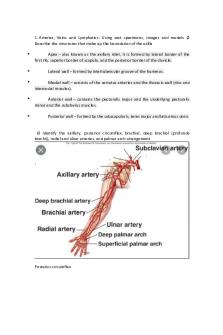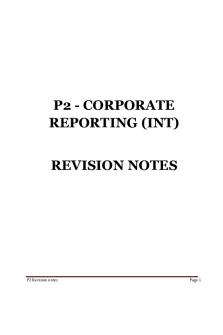P2 Simbucket simulation Concave mirrors PDF

| Title | P2 Simbucket simulation Concave mirrors |
|---|---|
| Course | Digital Communication for Modern Learning |
| Institution | University of Cincinnati |
| Pages | 4 |
| File Size | 53.6 KB |
| File Type | |
| Total Downloads | 70 |
| Total Views | 154 |
Summary
Lab report followed by questions on what was observed from the experiment. Simbucket simulation with concave mirrors....
Description
Simbucket simulation Concave mirrors 1. 2. 3. 4. 5. 6. 7.
Experiment with the tabs and adjustments on the simulation Set the optical device to mirror (top middle) For now, turn off all three arrows (bottom of screen) Switch object to an arrow (top tab) Set the focal length (f) at 20cm This will set the center of curvature (2f) at 40cm because it is 2 times focal length Place the arrow anywhere outside of 2f. Record this distance (given at bottom right) as distance to object (do). Record this value (it should be greater than 40cm)________________ 8. With the height (marked (H)) make the height of the object/arrow 10cm. 9. Look at bottom right and record all of the data: Object distance (do)____________ Object height (ho)______________ Image distance (di)_____________ Image height (hi)_______________ 10. What is the sign of the height of the image (hi)? Is it positive or negative?
11. Looking at the image in the simulation, what do you think the height of the image is represented with a negative? Consider if it is real and inverted or virtual and upright. Which is it and why would the height be a negative?
12. What do you think is the sign of the height of the image is if it is a virtual and upright image? You will validate this prediction in a little bit.
13. Keep the object outside of 2f (distance to object greater than 40 cm) but move it farther and closer to the mirror. What happens to the image when you move the object? Write a summary statement about the image when the object is outside 2f.
14. How does the distance to the image change as the distance of the object change? Write a summary statement.
15. There are mathematical equations that express these relationships. The first is 1/f= 1/do + 1/di where f is the focal length, do is the distance to the object and di is the distance to the image. Use the equation to solve the following problem. If the focal length is 15 cm, the distance to the object is 35 cm, what is the distance to the image? Show the work and circle your final answer.
16. Use the simulation making the focal length 15 cm and place the arrow at 35cm, does the distance to the image agree with what you found in the previous problem?
17. The second equation is the magnification equation. Magnification = hi/ho= - di/do where hi is the height of the image, ho is the height of the object, di is the distance to the image (measured from the mirror) and the do is the distance to the object (measured from the mirror). Use these equations to solve the following problem. If the focal length is 10 cm and the distance to the object is 30 cm, what is the distance to the image? What is the distance to the image? Show the work and circle your final answer.
18. If the object is 10 cm high, what is the height of the image? Show your work and circle the final answer.
19. Confirm your answer with the simulation. Does it agree? 20. Is this a virtual or real image? How can you tell?
21. Go back to the simulations and add ray 1 and ray 2. Notice how the reflected rays show you where the image is produced. Diagram the ray diagram below.
22. 23. 24. 25. 26. 27.
Move the object to 2f. compete the data table below: Object distance (do)____________ Object height (ho)______________ Image distance (di)_____________ Image height (hi)_______________ Write a summary statement about the image produced when an object is placed at 2f. In your summary statement talk about type of image (virtual or real), orientation (inverted or upright) and size (smaller, same size, larger) than object.
28. 29. 30. 31. 32. 33.
Place the object between 2f and f. Complete the data table: Object distance (do)____________ Object height (ho)______________ Image distance (di)_____________ Image height (hi)_______________ Write a summary state about the object placed between f and 2f. . In your summary statement talk about type of image (virtual or real), orientation (inverted or upright) and size (smaller, same size, larger) than object.
34. Place the object at f. What does the data table indicate about the image?
35. 36. 37. 38. 39. 40.
Place the object inside f. complete the data table Object distance (do)____________ Object height (ho)______________ Image distance (di)_____________ Image height (hi)_______________ Write a summary statement about the object inside f. . In your summary statement talk about type of image (virtual or real), orientation (inverted or upright) and size (smaller, same size, larger) than object.
Summary questions 41. The objects placement relative to 2f determines which: a. The size b. The type of image 42. The objects placement relative to f determines which: a. The size b. The type of image 43. A negative height of the image indicates that the image is: a. Virtual and upright b. Virtual and inverted c. Real and upright d. Real and inverted 44. A positive height of the image indicates that the image is: a. Virtual and upright b. Virtual and inverted c. Real and upright d. Real and inverted....
Similar Free PDFs

Funzioni convesse e concave
- 5 Pages

Concave Convex Rule Flaws
- 3 Pages

Concave and convex functions
- 2 Pages

Simulation
- 14 Pages

Simulation
- 20 Pages

Insight P2
- 11 Pages

P2 - 11111111111
- 6 Pages

P2 notes
- 198 Pages

Assessment p2
- 3 Pages

Mirrors and lens - lab report
- 3 Pages

Simulation assignment
- 5 Pages
Popular Institutions
- Tinajero National High School - Annex
- Politeknik Caltex Riau
- Yokohama City University
- SGT University
- University of Al-Qadisiyah
- Divine Word College of Vigan
- Techniek College Rotterdam
- Universidade de Santiago
- Universiti Teknologi MARA Cawangan Johor Kampus Pasir Gudang
- Poltekkes Kemenkes Yogyakarta
- Baguio City National High School
- Colegio san marcos
- preparatoria uno
- Centro de Bachillerato Tecnológico Industrial y de Servicios No. 107
- Dalian Maritime University
- Quang Trung Secondary School
- Colegio Tecnológico en Informática
- Corporación Regional de Educación Superior
- Grupo CEDVA
- Dar Al Uloom University
- Centro de Estudios Preuniversitarios de la Universidad Nacional de Ingeniería
- 上智大学
- Aakash International School, Nuna Majara
- San Felipe Neri Catholic School
- Kang Chiao International School - New Taipei City
- Misamis Occidental National High School
- Institución Educativa Escuela Normal Juan Ladrilleros
- Kolehiyo ng Pantukan
- Batanes State College
- Instituto Continental
- Sekolah Menengah Kejuruan Kesehatan Kaltara (Tarakan)
- Colegio de La Inmaculada Concepcion - Cebu




